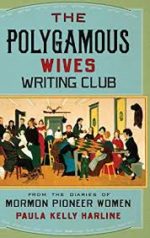Articles/Essays – Volume 48, No. 1
Full Lives but Not Fulfilling | Paula Kelly Harline, The Polygamous Wives Writing Club: From the Diaries of Mormon Pioneer Women
This book is a gem. Paula Kelly Harline’s writing shines. She has compiled excerpts from twenty-nine diaries and autobiographies of women who lived in polygamy between 1847, when the Mor mons first arrived in Utah, and 1890, when the Manifesto was issued and polygamy was abandoned by the LDS Church. Harline chose women who were not married to Church leaders because she wanted to know “how common folk understood and lived polygamy” (4). Other criteria were that the women did not leave the Church or move to Mexico or Canada to escape prosecution. And finally, she focused on writings that were not widely known.
Harline organized the book into three sections: (1) Settling Utah Territory: Polygamous Yet Monogamous; (2) Making Sense of Sisterhood: Relations between Wives; and (3) Abandoning Polygamy: Weariness. Within these sections are chapters, each of which covers the lives of two or three women who shared something in common: first wives who were initially willing for their husbands to take another wife; single women who arrived in Utah at a somewhat older age and quickly married polygamists; first wives living in Provo who bore the difficulties of polygamy by taking the upper hand over the other wives; women who strove to maintain their self-respect and even sanity when their husbands took other wives; three women in Arizona who experienced mental anguish and even physical pain because of polygamy; women who never really loved their husbands; wives who, during the 1880s and 1890s, had to hide to protect their husbands from prosecution for “cohabitation”; wives who “grew rebellious” and left their husbands to find better ways to support and educate their children; and one girl forced into polygamy at age fourteen who eventually escaped her husband only to marry a monogamous man who made her life difficult in other ways. Each chapter about the wives begins with a map that locates where each lived and moved to or from. The maps help the reader keep the individual women straight as the author interweaves their stories.
Harline imagines that the women would have loved to share their writings with the others in the same chapter, for they often lived not far from each other. Harline further explains, “The idea of writing clubs first came to me after watching seven Mormon Relief Society women in my Utah Valley neighborhood meet monthly to share their personal writings, and I imagined that nineteenth-century women could have done the same. . . . I lightly employ the writing club as a device to organize, to engage general readers, and to bring the wives’ flesh-and-blood nonfiction lives to the forefront” (4).
Interspersed among the chapters about the women are three essays or “interludes” that discuss how polygamy was defended by the Church and by women living in plural marriages, how rarely the wives in a family got along, and how the 1890 Manifesto came as a relief to some of the women. In the final chapter, Harline reveals some of her ancestors’ experiences with plural marriage and then gives a brief history of polygamy from Joseph Smith’s revelation to the 1890 Manifesto and on to how Church leaders view polygamy today.
Although the organization may sound overly complex, the book flows and quickly engrossed this reader. Harline skillfully weaves together the raw lives of these women and comments on insights gained from their writings. She admits that she originally believed polygamy was a positive force for women, freeing them to pursue personal interests thanks to the cooperation among the wives. But as she studied their writings, it became apparent that for these women life was difficult, sisterhood rarely worked out, and though their lives were full, they were not fulfilling.
So what is unique here compared to other excellent books about polygamy? In contrast to other works, Harline does not attempt a demographic study or analyze statistics of those living in polygamy but rather describes the reactions and moods of these women who struggled to live the religious principle. The diaries, in contrast to the autobiographies, which were usually written late in life, are more apt to reveal the emotional ups and downs of the women and often served as their only outlet for expressing anger or disappointment.
One feature of plural marriages especially caught my eye: “Most polygamous wives’ personal writings provide evidence of the underlying tension between the expectations of monogamy and the practice of polygamy. Even while living polygamy, inertia pulled wives back to their cultural DNA—Adam and Eve alone” (22).
The book is marred by occasional errors in fact: Joseph Smith was born in Vermont, not New York, and the temple in Ohio was never used for marriage sealings (6); Martha Heywood was the third, not second, wife of Joseph Heywood (34, photo); and an Illinois mob, not one in Missouri, killed Joseph Smith (155). These are minor glitches in a remarkable work.
I highly recommend this book for its portrayal of the women’s varied and mostly negative reactions to living in polygamy even when they believed in the principle.
Paula Kelly Harline. The Polygamous Wives Writing Club: From the Diaries of Mormon Pioneer Women. New York: Oxford UP, 2014. 256 pp. Photographs, maps, notes, index. Hardcover: $29.95. ISBN: 9780199346509.


 Back to full Issue
Back to full Issue

